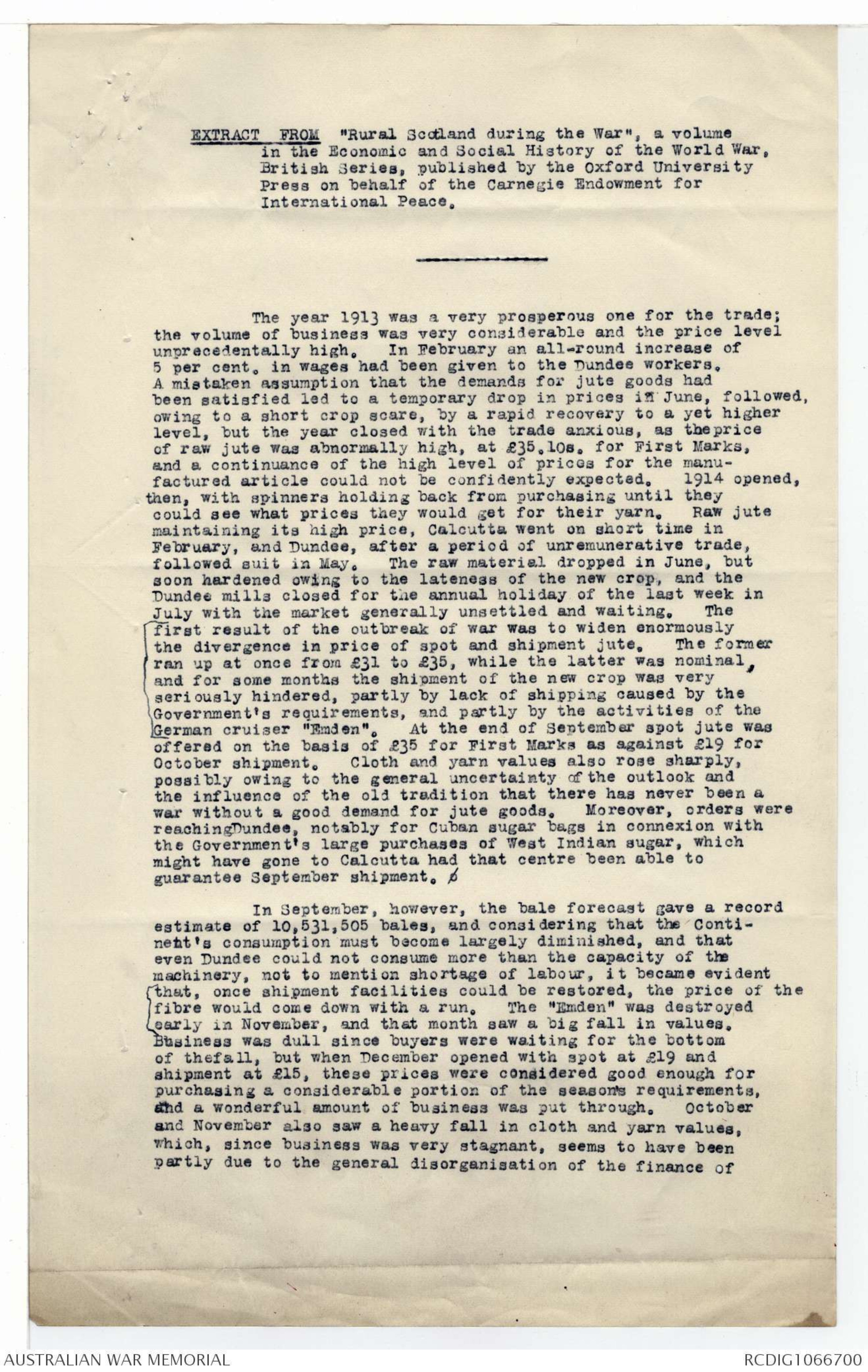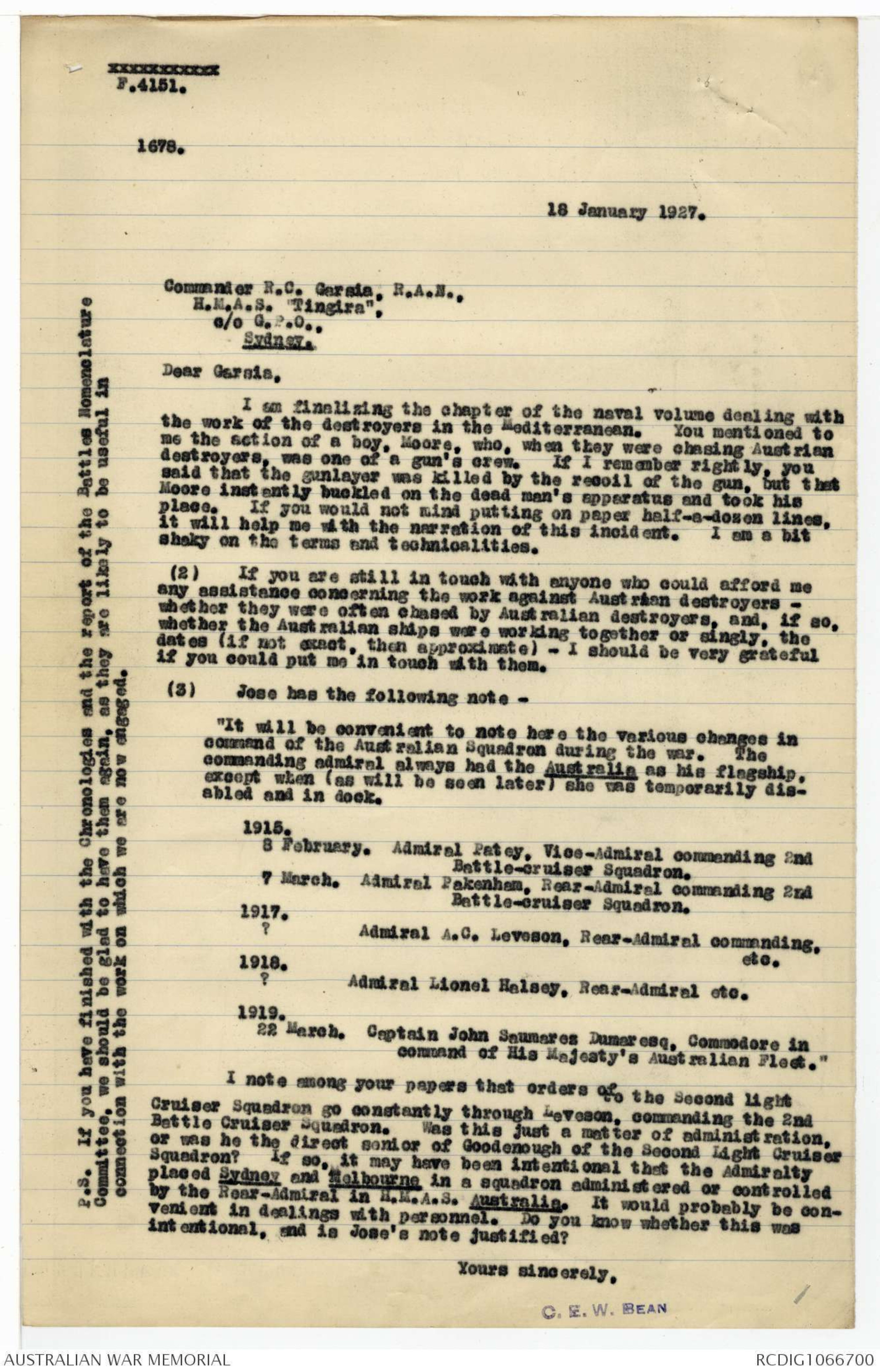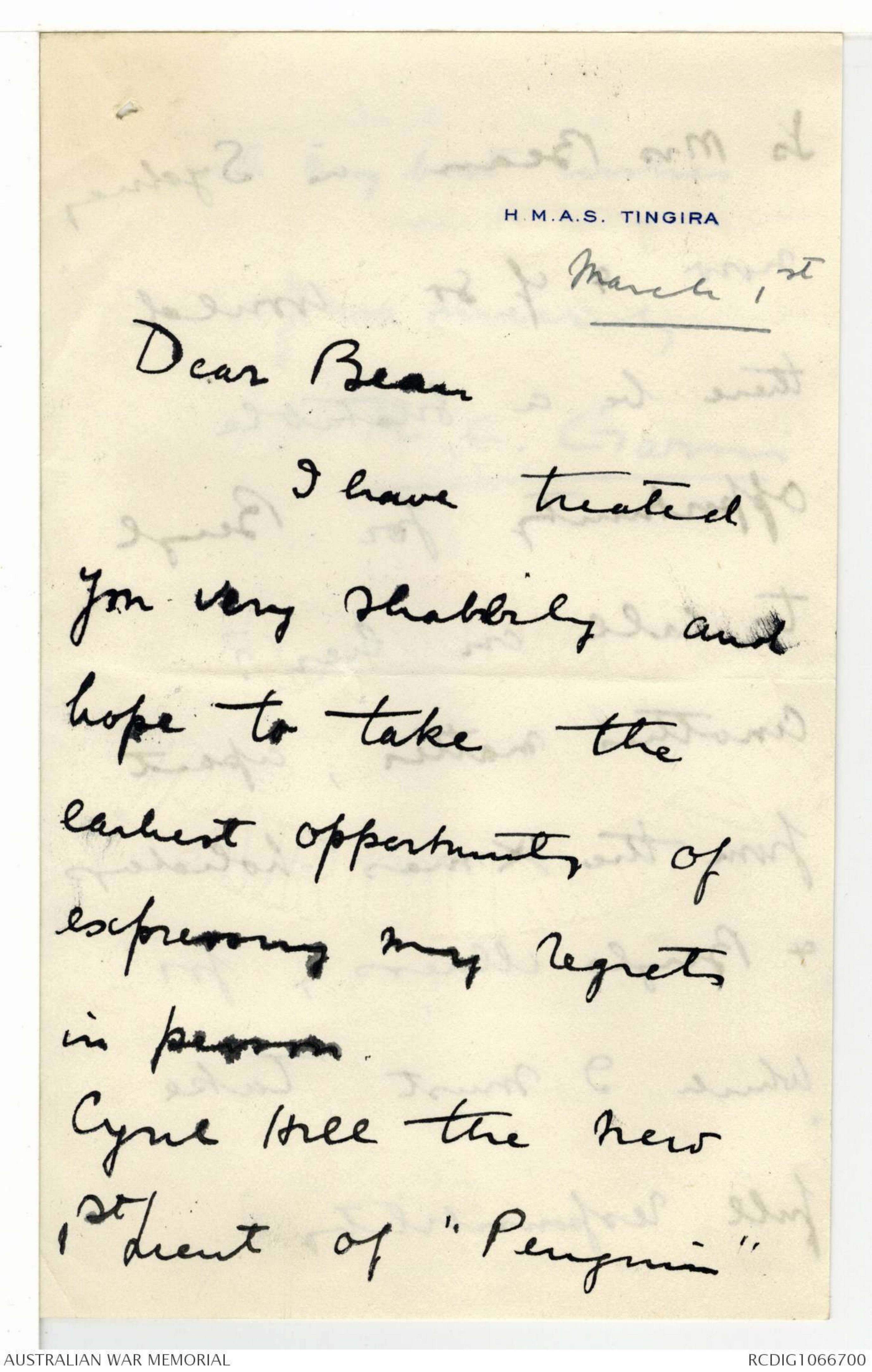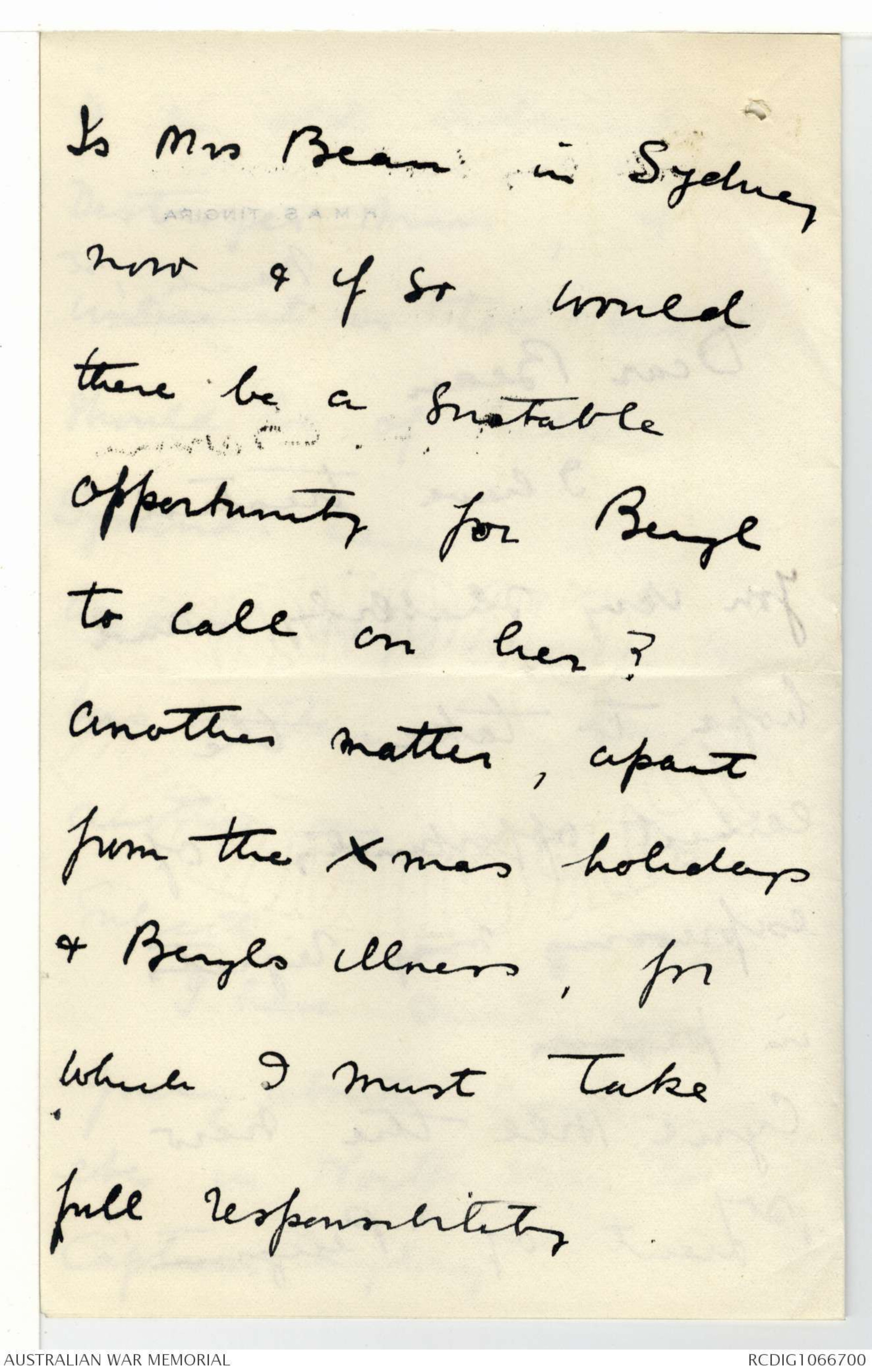Charles E W Bean, Diaries, AWM38 3DRL 606/264/1 - 1914 - 1938 - Part 6










An unofficial note on the Sydney -
Emden action
When Capt Muller
boarded the Sydney he
had no clothes with him
other than those in which he
was dressed at the time.
When he came to retire
at night Captain Gessop.
somewhat embarrassed,
told he Muller that he
couldn't let him have
a pair of pyjamas as
he always wore a
night-shirt. Muller
said "So do I".
Captain Cumberlege
told this story at one of
battle lecture seasons [[?]]
Sydney. It sounded
funnier when he told
it than it seems to be
when written
JM
EXTRACT FROM "THE TIMES" LONDON. 18/12/14.
THE EMDEN'S LOSSES.
An Officer in the Indian Army writes from Ceylon on
November 20th:-
We have had the excitement of having the wounded of the Emden
brought here. They came on the Sydney, the cruiser who sank her.
I rowed round her as she came in and saw the unfortunate wounded
Germans lying on the deck, and also the one shot hole in her side.
I afterwards went to the hospital with --- who was commandeered as an
interpreter. There I conversed with the British wounded off the
Sydney. They were not very bad - mostly burns all over, and a few
splinters lodged in their bodies. They were full of it, and, once
launched in a description of the fight, nothing could stop them. I
gathered the Sydney was warned by getting a wireless message from
Cocos Islands station just before the Emden's party landed to destroy
it. She put on full speed, and they managed to whack her up to 29
knots. When she sighted the Emden the latter was anchored, but came
out to "give battle" as one of the wounded warriors magnificently
described it. The Emden got her first three shots in, which were the
only ones she landed, as after that the Sydney took care to keep out
of range as she had larger guns. She planked in 600 rounds, and after
1½ hours action, during which she covered 56 miles in manoeuvring,
forced the Emden to beach herself, as her steering gear was broken.
The Emden went on the beach at 19 knots, the shock killing the man at
the wheel. The Sydney then put up a signal to them to surrender, but
as all the A.B's. on deck except three had been killed it was not done.
The Sydney accordingly give her two more broadsides as she lay on the
beach, when the Germans succeeded in showing a sheet. The Sydney
then left her and went off to sink the collier which was attending the
Emden. Having done this, she returned to the Emden, and sent parties
to help the survivors and wounded. They say the Emden was a perfect
shambles and every one who went on to her was sick, as there were
nearly 200 killed. The wounded were taken out of the ship, which had
caught fire, and put on the beach, where some of them were left for
two days before being attended. The Germans tore up their flag and
threw it into the sea.
There is one officer from the Emden in hospital slightly
wounded. I had a talk with him, as he speaks English. He was very
sad and told me that he was the only officer of deck not killed.
Some of the wounded are pretty beastly sights, as shell splinters make
nasty holes, and the work is generally g finished up by fire. I went
round and gave them cigarettes, which they seemed very glad to have.
They seemed kindly and cheery men. They were very plucky, and I did
not hear a groan as they had their wounds dressed, &c, although it
must have hurt some.
F2597
F2598
TELEPHONE NOS.
CENT. 297}
298}
COMMUNICATIONS TO BE ADDRESSED TO
"THE DIRECTOR."
IN REPLY PLEASE QUOTE
NO.
COMMONWEALTH OF AUSTRALIA.
HOME AND TERRITORIES DEPARTMENT.
TELEGRAPHIC ADDRESS
"AUSWARMUSE."
AUSTRALIAN WAR MEMORIAL.
EXHIBITION BUILDINGS, MELBOURNE.
21st July, 1926.
Dear Mr. Bazley,
I am sending herewith an extract from "Rural
Scotland during the War", a volume in the Economic and
Social History of the World War, British Series, published
by the Oxford University Press on behalf of the Carnegie
Endowment for International Peace. It may be of interest
to you in connection with Volume 9 of the History as showing
one of the results which followed the destruction of the
"Emden" by the "Sydney".
Yours sincerely,
J L Treloar
Mr. A.W. Bazley,
C/o Official Historian,
Victoria Barracks,
Sydney, N.S.Wales.
EXTRACT FROM "Rural Scotland during the War", a volume
in the Economic and Social History of the World War,
British Series, published by the Oxford University
Press on behalf of the Carnegie Endowment for
International Peace.
The year 1913 was a very prosperous one for the trade;
the volume of business was very considerable and the price level
unprecedentally high. In February an all-round increase of
5 per cent. in wages had been given to the Dundee workers.
A mistaken assumption that the demands for jute goods had
been satisfied led to a temporary drop in prices in June, followed,
owing to a short crop scare, by a rapid recovery to a yet higher
level, but the year closed with the trade anxious, as the price
of raw jute was abnormally high, at £35.10s. for First Marks,
and a continuance of the high level of prices for the manufactured
article could not be confidently expected. 1914 opened,
then, with spinners holding back from purchasing until they
could see what prices they would get for their yarn. Raw jute
maintaining its high price, Calcutta went on short time in
February, and Dundee, after a period of unremunerative trade,
followed suit in May. The raw material dropped in June, but
soon hardened owing to the lateness of the new crop, and the
Dundee mills closed for the annual holiday of the last week in
July with the market generally unsettled and waiting. The
first result of the outbreak of war was to widen enormously
the divergence in price of spot and shipment jute. The former
ran up at once from £31 to £35, while the latter was nominal,
and for some months the shipment of the new crop was very
seriously hindered, partly by lack of shipping caused by the
Government's requirements, and partly by the activities of the
German cruiser "Emden". At the end of September spot jute was
offered on the basis of £35 for First Marks as against £19 for
October shipment. Cloth and yarn values also rose sharply,
possibly owing to the general uncertainty of the outlook and
the influence of the old tradition that there has never been a
war without a good demand for jute goods. Moreover, orders were
reaching Dundee, notably for Cuban sugar bags in connexion with
the Government's large purchase of West Indian sugar, which
might have gone to Calcutta had that centre been able to
guarantee September shipment. o
In September, however, the bale forecast gave a record
estimate of 10,531,505 bales, and considering that the Continent's
consumption must become largely diminished, and that
even Dundee could not consume more than the capacity of the
machinery, not to mention shortage of labour, it became evident
that, once shipment facilities could be restored, the price of the
fibre would come down with a run. The "Emden" was destroyed
early in November, and that month saw a big fall in values.
Business was dull since buyers were waiting for the bottom
of the fall, but when December opened with spot at £19 and
shipment at £15, these prices were considered good enough for
purchasing a considerable portion of the season's requirements,
and a wonderful amount of business was put through. October
and November also saw a heavy fall in cloth and yarn values,
which, since business was very stagnant, seems to have been
partly due to the general disorganisation of the finance of
-2-
foreign trade,oo and partly to buyers holding off for the
anticipated fall, and partly to the great restriction on
exportation to neutral European countries and the great
delay in obtaining special export licences. Possibly also
the release of the accumulated stocks in Calcutta had its effect.
On the 26th of November the Garden Works of J. C. Duffus and
Nephew were closed down. Prices revived in December in
sympathy with the raw material, and business became very
brisk.
o These bags, which had been sold in Calcutta in July at
69s.6d. net per 100, Cuban ports, were brought as high as
112s.6d. per 100 less three per cent c.i.f. for Liverpool.
oo The Government scheme of relief to export merchants was
announced on the 3rd of November.
F.4151.
1678.
18 January 1927.
Commander R.C. Garsia, R.A.N.,
H.M.A.S. "Tingira",
c/o G.P.O.,
Sydney.
Dear Garsia,
I am finalizing the chapter of the naval volume dealing with
the work of the destroyers in the Mediterranean. You mentioned to
me the action of a boy, Moore, who, when they were chasing Austrian
destroyers, was one of a gun's crew. If I remember rightly, you
said that the gunlayer was killed by the recoil of the gun, but that
Moore instantly buckled on the dead man's apparatus and took his
place. If you would not mind putting on paper half-a-dozen lines,
it will help me with the narration of this incident. I am a bit
shaky on the terms and technicalities.
(2) If you are still in touch with anyone who could afford me
any assistance concerning the work against Austrian destroyers -
whether they were often chased by Australian destroyers, and, if so,
whether the Australian ships were working together or singly, the
dates (if not exact, then approximate) - I should be very grateful
if you could put me in touch with them.
(3) Jose has the following note -
"It will be convenient to note here the various changes in
command of the Australian Squadron during the war. The
commanding admiral always had the Australia as his flagship,
except when (as will be seen later) she was temporarily disabled
and in dock.
1915.
8 February. Admiral Patey, Vice-Admiral commanding 2nd
Battle-cruiser Squadron.
7 March. Admiral Pakenham, Rear-Admiral commanding 2nd
Battle-cruiser Squadron.
1917.
? Admiral A.C. Leveson, Rear-Admiral commanding, etc.
1918.
? Admiral Lionel Halsey, Rear-Admiral etc.
1919.
22 March. Captain John Saumares Dumaresq, Commodore in
command of His Majesty's Australian Fleet."
I note among your papers that orders ofto the Second light
Cruiser Squadron go constantly through Leveson, commanding the 2nd
Battle Cruiser Squadron. Was this just a matter of administration,
or was he the direct senior of Goodenough of the Second Light Cruiser
Squadron? If so, it may have been intentional that the Admiralty
placed Sydney and Melbourne in a squadron administered or controlled
by the Rear-Admiral in H.M.A.S. Australia. It would probably be convenient
in dealings with personnel. Do you know whether this was
intentional, and is Jose's note justified?
Yours sincerely,
C. E. W. BEAN
[*P.S. If you have finished with the Chronologies and the report of the Battles Nomenclature
Committee, we should be glad to have them again, as they are likely to be useful in
connection with the work on which we are now engaged.*]
H.M.A.S. TINGIRA
March 1st
Dear Bean
I have treated
you very shabbily and
hope to take the
earliest opportunity of
expressing my regrets
in person.
Cyril Hill the new
1st Lieut of "Penguin"
Is Mrs Bean in Sydney
now & if so would
there be a suitable
opportunity for Beryl
to call on her?
Another matter, apart
from the Xmas holidays
& Beryls illness, for
which I must take
full responsibility
with my best wishes
Yours sincerely
R. C. Garsia
 Deb Parkinson
Deb ParkinsonThis transcription item is now locked to you for editing. To release the lock either Save your changes or Cancel.
This lock will be automatically released after 60 minutes of inactivity.